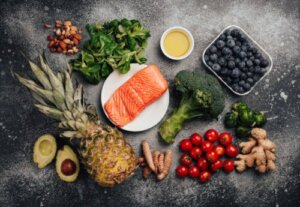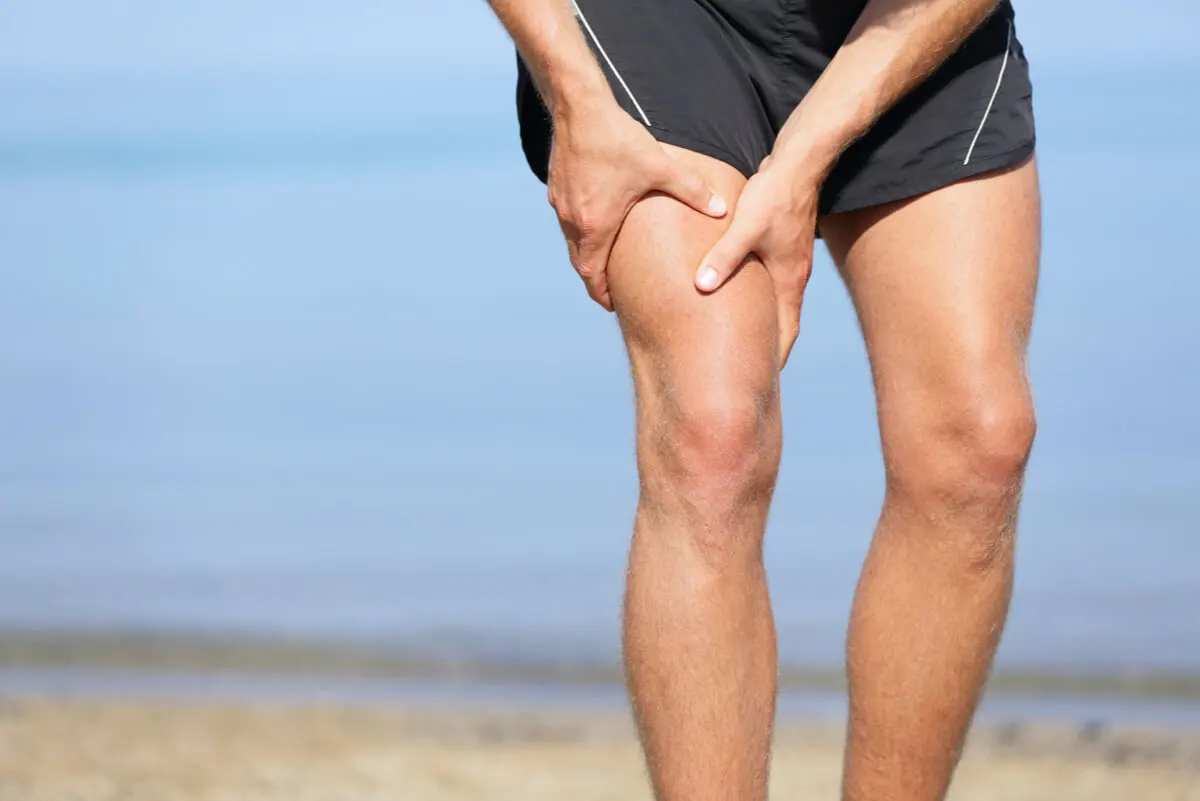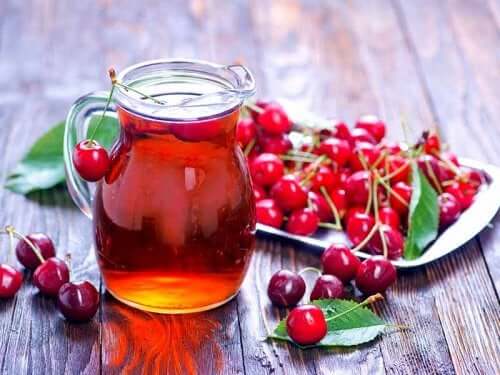Nutritional Strategies to Reduce Muscle Inflammation


Written and verified by the nutritionist Maria Patricia Pinero Corredor
Exercising muscles is part of a healthy and active lifestyle. However, when the intensity of exercise increases, pain appears. To a certain extent, the process is normal, but a chronic condition should be avoided, and there are several nutritional strategies to reduce muscle inflammation.
Balanced diets can prevent inflammatory processes. In particular, some foods, due to their anti-inflammatory properties, can be used in the presence of muscle injuries.
In this article, we’ll give you concise information so that you can identify products that can help you reduce the muscle inflammation that occurs with exercise. Keep reading!
What is muscle inflammation?
Inflammation is a natural process that helps the body to defend and heal itself. It’s a mechanism that the body sets in motion to attack invading agents and mobilize the compounds necessary for tissue reconstruction.
In addition, anti-inflammatory substances are activated to minimize damage. When the process is maintained over time, it becomes chronic.
The Spanish Society of Internal Medicine explains that muscular pain is very frequent and can involve ligaments, tendons, and fascia. The latter is the tissue that surrounds the organs.
This inflammatory process is a reaction of the muscles when they’re subjected to a stressful situation. Overexertion in sports can be one of the causes, as well as a bad stretch or trauma.
According to the Mayo Clinic, in most cases, muscle aches disappear on their own in a short time and are usually relieved with simple home treatment. However, there are some that remain for months and require medical attention.
You may be interested in: What Are Pro-Inflammatory Foods and What Are The Risks?
What is an anti-inflammatory diet?
An anti-inflammatory diet is one that contains foods whose nutrients can decrease inflammation. It’s based on prioritizing foods rich in antioxidants and other substances that fight inflammation.
In the meantime, ingredients that trigger a pro-inflammatory response are avoided.
To reduce muscle inflammation we must select the right foods. In this way, diet doesn’t only relieve pain, but can also prevent future damage.

The best nutritional strategies to reduce muscle inflammation
Many of the active components in food provide anti-inflammatory activity, which promotes a balance between the body’s natural inflammation and anti-inflammation. Several mechanisms have been proposed to explain the anti-inflammatory effects of different foods.
Regulation of cytokines and proinflammatory enzyme activity is thought to be the key to the process.
Strategies to counteract muscle inflammation include supplementation with certain nutrients or increased consumption of active components, which we’ll describe below.
Include more omega-3 fatty acids
The effect of polyunsaturated fatty acids, such as docosahexaenoic (DHA), eicosapentaenoic (EPA) and arachidonic (AA), on the synthesis of certain molecules (prostaglandins, thromboxanes and leukotrienes), is a known action of these nutrients. For this reason, it’s important to have a balance between these fatty acids.
For example, if arachidonic fatty acid (AA) predominates, the pro-inflammatory situation increases. Some studies reveal that a diet high in fruits, vegetables, and whole grains, supplemented with EPA-rich oils, can reduce the production of proinflammatory compounds.
On the other hand, one group of experts found that omega-3 intake may be effective in improving exercise-induced delayed onset muscle soreness. Participants were given 1.8 grams per day of omega-3, distributed as 324 milligrams of EPA and 216 milligrams of DHA. This dose improved muscle pain 48 hours later.
Scientific literature also shows that some fatty fish, such as salmon, sardines, herring and anchovy, are good sources of EPA and DHA. Nuts and seeds of chia, flaxseed and sesame, soybean oil and olive oil, among others, are also considered sources of omega-3.
The recommended amounts of these fatty acids depend on age and sex. For example, adult men require 1.6 grams and women 1.1 grams per day.
Find out: What Are Omega Fatty Acids 3, 6, and 9?
Include some spices and herbs in your diet
Seasonings, spices and herbs have a high antioxidant power. Specifically, turmeric contains an active ingredient called curcumin, noted as an anti-inflammatory and analgesic.
This rhizome is considered a protective factor against inflammation, oxidative damage, and cell death. Some studies show that doses of 2 to 10 grams of turmeric, for more than 6 weeks, are protective.
To demonstrate the effect of curcumin on muscle inflammation, a study was conducted in mice that were given 10 milligrams per day of this active ingredient. It was found that supplementation decreased pro-inflammatory cytokines 24 and 48 hours after exercise.
Human studies, conducted by a group of Chinese experts, revealed the efficacy of curcumin in protecting against exercise-induced muscle damage. Therefore, it can be considered a recovery agent by inhibiting the formation of free radicals.
Green tea is another ingredient in this group, as it contains many polyphenols that, when absorbed, exert antioxidant and anti-inflammatory functions. A consumption of more than 6 cups of green tea per day was able to inhibit the production of pro-inflammatory cytokines. Stevia also reduces these inflammation-promoting molecules.
Drink more cherry juice
Consuming a variety of fruits ensures a sufficient intake of micronutrients and dietary fiber. In addition to phytochemicals with antioxidant and anti-inflammatory effect.
Within the group of phytochemicals are anthocyanins, which are red bioactive pigments. They’re able to act in different cells and tissues, preventing systemic inflammatory processes.
In this sense, the efficacy of cherry juice, equivalent to 50 or 60 cherries, was evaluated to prevent muscle damage after exercise. Those who drank the cherry juice reported less soreness and less loss of strength after training.
Cherry juice was also used for marathon runners, with an equivalent of 40 milligrams of anthocyanin and 600 milligrams of phenolic compounds. The group of athletes who ingested the juice regained strength in less time, had less muscle inflammation and low oxidative stress.

What food should you avoid?
Some foods can contribute to the inflammatory process and should be avoided. Products with trans fats, such as hydrogenated shortenings and margarines, oils containing omega-6, and saturated fats should be avoided.
Other foods that can contribute to inflammation include the following:
- Soft drinks
- Refined carbohydrates
- Simple sugars
- Fried foods
- Red and processed meats
Empty calorie foods, which provide no essential nutrients or antioxidants, can promote chronic inflammation. In contrast, the Mediterranean style diet, rich in vegetables, legumes, nuts, fresh fruits, whole grains, wine, olive oil and fish, prevents inflammatory processes.
Are these strategies enough to reduce muscle inflammation?
The first thing to consider is that more research is needed to target the relationship between nutrients and muscle inflammation. In addition, we must keep the body loaded with antioxidants to deal with free radical damage.
We need to lead a lifestyle that guarantees a healthy diet, with a tendency to prevent diseases, balanced, varied, sufficient in quantity and of good quality.
While making these changes in the diet plan, we can eat more fatty fish or omega 3 supplements, always following the advice of a nutritionist. We should try to meet the basic recommendations of 1.1 to 1.6 grams of EPA and DHA per day.
We could also increase the consumption of turmeric, at least up to 2 grams per day. In the same way, it’s recommended to replace part of the daily water with cherry juice, at least 24 hours before any heavy exercise.
All cited sources were thoroughly reviewed by our team to ensure their quality, reliability, currency, and validity. The bibliography of this article was considered reliable and of academic or scientific accuracy.
- MayoClinic. Dolor muscular. Disponible en: https://www.mayoclinic.org/es-es/symptoms/muscle-pain/basics/causes/sym-20050866?p=1
- Sociedad Española de Medicina Interna. SEMI. Dolor muscular. Disponible en: https://www.fesemi.org/informacion-pacientes/conozca-mejor-su-enfermedad/dolor-muscular
- Sarah L. Patterson, M.D. & Sara K. Tedeschi, M.D. Osher Center for Integrative Medicine. Alimentos antiinflamatorios. Recomendaciones nutricionales para personas con enfermedades reumáticas. Disponible en: https://osher.ucsf.edu/sites/osher.ucsf.edu/files/2021-06/HEALER_Nutrition-Book_final_Spanish-language.pdf
- Tartibian B, Maleki BH, Abbasi A. The effects of ingestion of omega-3 fatty acids on perceived pain and external symptoms of delayed onset muscle soreness in untrained men. Clinical Journal of Sport Medicine : Official Journal of the Canadian Academy of Sport Medicine. 2009 Mar;19(2):115-119. DOI: 10.1097/jsm.0b013e31819b51b3. PMID: 19451765.
- Bellik Y, Hammoudi SM, Abdellah F, Iguer-Ouada M, Boukraâ L. Phytochemicals to prevent inflammation and allergy. Recent Pat Inflamm Allergy Drug Discov. 2012;6(2):147-58. Disponible en: https://pubmed.ncbi.nlm.nih.gov/22352960/
- Medina A, Casas R, Tressserra A, Ros E, Martínez MA, Fitó M, et al. Polyphenol intake from a Mediterranean diet decreases inflammatory biomarkers related to atherosclerosis: A sub-study of The PREDIMED trial. Br J Clin Pharmacol. 2016 Apr 21. doi: 10.1111/ bcp.12986. Disponible en: https://pubmed.ncbi.nlm.nih.gov/27100393/
- Castro-González María Isabel. Acidos grasos omega 3: beneficios y fuentes. INCI [Internet]. 2002 Mar [citado 2022 Jul 14] ; 27( 3 ): 128-136. Disponible en: http://ve.scielo.org/scielo.php?script=sci_arttext&pid=S0378-18442002000300005&lng=es.
- National Institutes of Health. NIH. Acidos grasos omega-3. Disponible en: https://ods.od.nih.gov/factsheets/Omega3FattyAcids-DatosEnEspanol/
- Kuptniratsaikul, V., Dajpratham, P., Taechaarpornkul, W., Buntragulpoontawee, M., Lukkanapichonchut, P., Chootip, C., Saengsuwan, J., Tantayakom, K., & Laongpech, S. (2014). Efficacy and safety of Curcuma domestica extracts compared with ibuprofen in patients with knee osteoarthritis: a multicenter study. Clinical interventions in aging, 9, 451–458. https://doi.org/10.2147/CIA.S58535
- Wang Fang, Yasaman Nasir. The effect of curcumin supplementation on recovery following exercise-induced muscle damage and delayed-onset muscle soreness: A systematic review and meta-analysis of randomized controlled trials. Phytoterapy Research. 2021, Volume35, Issue4, Pages 1768-1781. Disponible en: https://pubmed.ncbi.nlm.nih.gov/33174301/
- J Mark Davis , E Angela Murphy, Martin D Carmichael, Mark R Zielinski, Claire M Groschwitz, Adrienne S Brown, J David Gangemi, Abdul Ghaffar, Eugene P Mayer. Curcumin effects on inflammation and performance recovery following eccentric exercise-induced muscle damage. Am J Physiol Regul Integr Comp Physiol. 2007 Jun;292(6):R2168-73.doi: 10.1152/ajpregu.00858.2006.
- Lopez HL. Nutritional interventions to prevent and treat osteoarthritis. Part II: Focus on micronutrients and supportive nutraceuticals. Osteoarthritis Supplement. 2012;4:S155-S68. Disponible en: https://pubmed.ncbi.nlm.nih.gov/22632695/
- Fengyang L, Yunhe F, Bo L, Zhicheng L, Depeng L, Dejie L, et al. Stevioside suppressed inflammatory cytokine secretion by downregulation of NF-κB and MAPK signaling pathways in LPSstimulated RAW264.7 cells. Inflammation. 2012;35(5):1669-75. Disponible en: https://pubmed.ncbi.nlm.nih.gov/22644339/
- Connolly, D. A. J., McHugh, M. P., Padilla-Zakour, O., Carlson, L., & Sayers, S. P. (2006). Efficacy of a tart cherry juice blend in preventing the symptoms of muscle damage. British Journal of Sports Medicine, 40(8), 679-83. Disponible en: https://www.ncbi.nlm.nih.gov/pmc/articles/PMC2579450/
- Howatson, G., McHugh, M. P., Hill, J. A., Brouner, J., Jewell, A. P., van Someren, ,K.A., . . . Howatson, S. A. (2010). Influence of tart cherry juice on indices of recovery following marathon running. Scandinavian Journal of Medicine & Science in Sports,20(6), 843-852. Disponible en: https://pubmed.ncbi.nlm.nih.gov/19883392/
- Caballero-Gutiérrez L, Gonzáles GF. Alimentos con efecto antiinflamatorio. Acta Med Peru. 2016;33(1):50-64. Disponible en: http://www.scielo.org.pe/pdf/amp/v33n1/a09v33n1.pdf
This text is provided for informational purposes only and does not replace consultation with a professional. If in doubt, consult your specialist.








